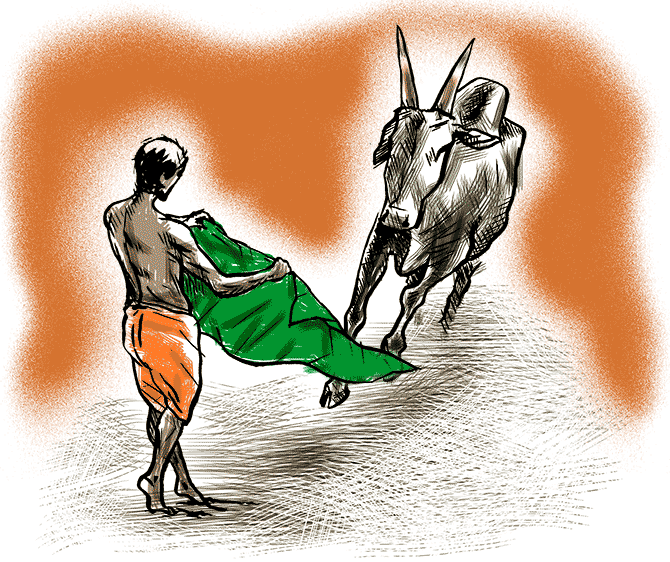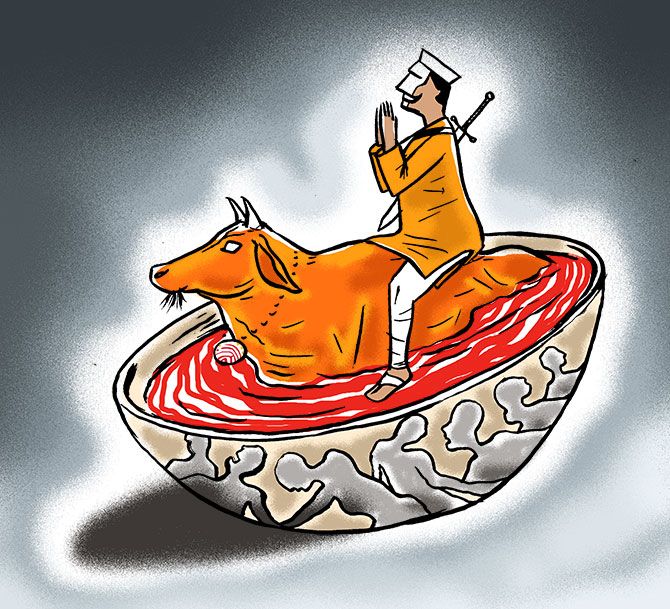As male bovines today account for only 28 per cent of India’s cattle, it clearly shows that it is the bulls and not the cows that are mostly being butchered. This makes it clear that cow slaughter is not a problem but the slaughter of male bovines is whose main utility today is in the value of their meat, says Murad Ali Baig.
Illustrations: Dominic Xavier/ Rediff.com.

Where have all the bullocks gone?
It should have been a big story. But the Indian media does not seem to have noticed.
Today, if you travel through any of India’s prosperous districts, you will very seldom see a bullock cart or a bull ploughing a field and no bulls circle any Persian wheel any longer. Over the past few decades, they have nearly all been replaced by tractors, trucks or pump sets.
A recent report from the Central Institute of Agricultural Engineering, Bhopal, shows that the share of draught animals for farm power on Indian farms declined from 44 per cent in 1971-1972 to a shocking 4 per cent in 2012-13.
Roughly 50 million male bovines have simply disappeared.
The 19th Livestock Census of India, 2012, shows that the number of cows surprisingly increased by 7.16 per cent to 216 million since the census of 2007, while the number of bulls and male buffaloes declined by an alarming 18.6 per cent to 84 million in the same period.
As male bovines today account for only 28 per cent of India’s cattle, it clearly shows that it is the bulls and not the cows that are mostly being butchered. This makes it clear that cow slaughter is not a problem but the slaughter of male bovines is whose main utility today is in the value of their meat.
Paradoxically, the efforts to protect the cow in many states makes the bulls even more of an economic liability.
Cattle are a major economic asset to almost every rural family and the meat industry including bovines, sheep, goats, pigs and poultry put money into the pockets of nearly every rural household. They are also part of rural wealth since they could be easily sold in times of economic hardship. It is the male animals (or birds) that are mostly used for meat as the females are more valuable as breeders and for milk or eggs.
The census data clearly shows that millions of male animals have been culled. Male buffaloes declined 17.8 per cent to just 16 million while females increased 7.99 per cent to 92 million. The productive female bovines are valuable but the males are nearly worthless if they cannot be slaughtered or sold.
They still need food and fodder that costs over Rs 100 a day to the poor owner. Hence bulls are killed for meat where it is allowed but in other states farmers have little choice but to try to callously drive them away to be devoured by dogs or wild animals.
India has a very serious problem with many millions of old and unproductive cattle, that are driven away until they die of hunger or illness. In desperation, the poor beasts raid other farms and face the wrath of farmers who mercilessly beat and even kill them.
Meat from surplus or stray cattle, in some states, is a very cheap food for the poor and usually costs a third of the cost of mutton. It is also the poor man’s protein and is mainly consumed by some 200 million Dalits and other tribal communities.
According to global figures about 40 per cent of the value of livestock comes from the sale of meat and hides. Farmers, therefore, suffer great economic loss wherever India's legislators ban or restrict the slaughter and sale of meat or beef products. The restrictions on the slaughter or sale of bulls or barren cows, therefore, puts farmers to such hardship that many are driven to suicide.
Religion should have no place in economic matters but there are such strong sentiments in many parts of India about protecting the cows and banning the consumption of beef that these affect the legislation. When states legislate against beef consumption, they unwittingly add many more unproductive cattle demanding land that is simply not available.
The gaushalas (cow sanctuaries) set up in many states are woefully inadequate to feed and maintain the many millions of worthless cattle. Media reports show that many such gaushalas just cannot provide enough food and fodder for the starving beasts.
There are no easy solutions. The NDA, ruling 20 states, will not find it easy to roll back the recent laws on cow slaughter or the trading in meat and beef products. Many of them are also powerless to restrain the gau rakshaks (cow saviours) and other passionate bhakts (Hindu puritans) who terrorise or kill poor farmers trying to sell their surplus cattle.
India has always been and still remains a substantially agro-based economy despite islands of urban prosperity. As the asset value of cattle declines, it puts a huge burden on India’s entire farming community already groaning with droughts, floods, unremunerative prices for crops, indebtedness and other grave problems.
Murad Ali Baig, who has a career in public relations, is published prolifically on widely different subjects including rural development, power, marketing and humour but is best known for his articles on automobiles. According to his online author bio: ‘He has a deep interest in history and religion and his 80 Questions to Understand India, History Mythology and Religion (Tara Press, New Delhi) has sold over 20,000 copies so far.’











